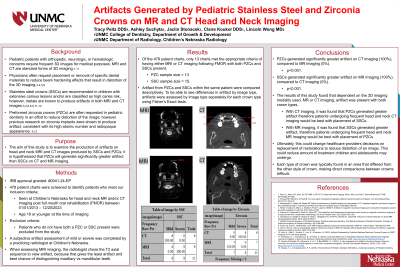Other
317 - Artifact Generated by Pediatric Crowns on Head and Neck Imaging


Tracy Peitz, DDS (she/her/hers)
House Officer II, Pediatric Dental Resident
University of Nebraska Medical Center Pediatric Dentistry
University of Nebraska Medical Center Pediatric Dentistry
Seward, Nebraska, United States- JS
Jaclin Stonacek, DDS in process
University of Nebraska Medical Center College of Dentistry
- AS
Ashley Suchyta, DDS in process
University of Nebraska Medical Center College of Dentistry
- LW
Lincoln S. Wong, MD
Children's Nebraska
- CK
Claire C. Koukol, DDS, MPH
Assistant Professor
university of nebraska medical center
University of Nebraska Medical Center
Omaha, Nebraska, United States - ZH
Zachary L. Houser, DMD
Program Director
University of Nebraska Medical Center
Omaha, Nebraska, United States
Presenting Author(s)
Co-Author(s)
Research Mentor(s)
Program Director(s)
Purpose: The purpose of this study is to examine the production of artifacts on head and neck CT and MR images caused by stainless steel crowns (SSCs) and preformed zirconia crowns (PZCs).
Methods: Charts within Children’s Nebraska EPIC software were reviewed of patients who have been seen for head and neck MRI and CT imaging following full mouth oral rehabilitation. Imaging was assessed and artifact was subjectively measured by a radiologist per crown type (SSCs and PZCs).
Results: Artifact from PZCs and SSCs within the same patient were compared descriptively. To be able to see differences in artifact by image type, artifacts were assessed by image type separately for each crown type using Fisher’s Exact tests.
Conclusions: PZCs generated significantly greater artifact on CT imaging (100%), compared to MR imaging (0%) with a p value < 0.001. SSCs generated significantly greater artifact on MR imaging (100%), compared to CT imaging (0%) with a p value < 0.001. Ultimately, this could change healthcare providers decisions on replacement of restorations to reduce distortion of an image. This could reduce amount of treatment children and adolescents may undergo.
Identify Supporting Agency and Grant Number: NA

.jpg)